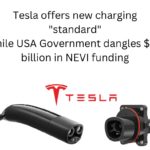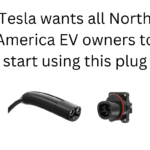Are “we” doing too-little-too-late to fend off the crises caused by peak oil and climate change and the impacts both will have on the world economy, our food systems, and more? Looking at the level of resistance against clean energy technologies like electric vehicles, it’s easy for gloom and doom to make us think our society will cling to fossil fuels like a junkie until the last drop is squeezed from the earths crust, an act that would doom our society to a worldwide cataclysm.
But there are days like this one, where a massive announcement is made and the future looks rosy. I’m talking about Tesla Motors announcing that Reno is the location of their Gigafactory. By itself the location of the Gigafactory doesn’t matter other than an economic revival of Nevada and the Reno area.
What matters here is that Tesla Motors is reiterating the goal of selling 500,000 electric vehicles per year by 2020. Another factoid which matters is that the factory will be completely powered by solar and wind power, located on site. Other factoids which matter are that the other carmakers are ramping up electric vehicle production, the cost of batteries is expected to fall, as is the cost of solar and wind power systems.
The Tesla Gigafactory gives us an encapsulated thing which demonstrates all these points, and shows a way towards a new energy paradigm that could save our collective bacon.
The picture above is an artists rendering of the site, which will be located in the Tahoe-Reno Industrial Center just east of Reno.
- 50 gigawatt-hours of battery production – 500,000 electric vehicles per year production
- Completely powered by renewable
- Net Zero Energy factory
The electric car revolution will take off in a big way once battery pack costs drop low enough. Electric cars could reach cost parity with equivalent gasoline cars, and then we’d enjoy the full benefit of how cheap a fuel electricity is.
I have some doubts whether Tesla will indeed have sales at the 500,000 level by 2020. It’s nice this is their goal, but the company’s history is that while they did meet their big goals often they were a little late. Okay, 500,000 EV’s a year by 2022 would be fine, right?
But, just think of the rapidity of this increase. The first mass market EV’s to go on sale were the Nissan Leaf and Chevy Volt, in late 2010. That’s less than 4 years ago, and the sales rate was very low – a few hundred cars a month each. Today it looks like 2014 will have well over 100,000 plug-in vehicles sold in the U.S. and well over 200,000 worldwide. By 2016 Tesla Motors intends to be selling well over 100,000 Model S and Model X luxury vehicles per year. By 2017 the company plans to launch the Model 3, with initial production of 100,000 vehicles per year, and rapidly increasing that to over 200,000 vehicles per year.
The other carmakers seem to be lining their ducks up for similar production/sales increases over the next few years, but those companies don’t seem to be as dedicated as Tesla is.
That’s one aspect of the Gigafactory, the role it plays in enabling Tesla to ramp up vehicle production to heights that we couldn’t conceive of in 2010. In 2010 I set out to build my own electric car![]() because I couldn’t afford a Tesla Roadster and the other carmakers weren’t stepping up to the plate. What a difference a few years makes.
because I couldn’t afford a Tesla Roadster and the other carmakers weren’t stepping up to the plate. What a difference a few years makes.
Next is the idea of a factory this size being a Net Zero Energy facility. How will this be accomplished? The picture shows a massive solar array on the roof, and a massive wind farm on the mountainside above the site. Additionally, one expects that Tesla Motors will use its battery pack production to set up a massive energy storage system to help time-shift the wind power production to daytime use. We know that Tesla intends to direct some of the battery packs to grid energy storage products.
Many are claiming the price of solar and wind energy systems is dropping so fast that within a few years they’ll be directly cost competitive, no subsidies required, against fossil fuel energy systems. A key component of renewable energy systems is handling their intermittency, by building grid energy storage systems. By decreasing battery pack costs, Tesla Motors could become a leader in that field.
Perhaps – maybe – if all this works out as projected – the economic cost factors will tilt towards renewable energy, electric vehicles, etc, and in a big way “we” would start adopting these technologies because they’re cheaper than fossil fuel systems.
A couple weeks ago I wrote about how the old energy paradigm (fossil fuels) is like cave men banging rocks together to make sparks to light fuel to get fire for heat and motion. The new energy paradigm is completely based on electricity, magnetism, and perhaps raw energy in a few years. The new energy paradigm is already widely used – such as all the electrical or computer gizmos surrounding us. We’re still stuck in the old paradigm in transportation, electricity generation, and other power systems that still run on fossil fuels. But, if all that I’ve just written about pans out, the economic engine could quickly shift to the new paradigm.
Maybe, just maybe, it will happen quickly enough to prevent the looming environmental and climate catastrophes.
- Highway design could decrease death and injury risk, if “we” chose smarter designs - March 28, 2015
- GM really did trademark “range anxiety”, only later to abandon that mark - March 25, 2015
- US Government releases new regulations on hydraulic fracturing, that some call “toothless” - March 20, 2015
- Tesla Motors magic pill to solve range anxiety doesn’t quite instill range confidence - March 19, 2015
- Update on Galena IL oil train – 21 cars involved, which were the supposedly safer CP1232 design - March 7, 2015
- Another oil bomb train – why are they shipping crude oil by train? – Symptoms of fossil fuel addiction - March 6, 2015
- Chevron relinquishes fracking in Romania, as part of broader pull-out from Eastern European fracking operations - February 22, 2015
- Answer anti- electric car articles with truth and pride – truth outshines all distortions - February 19, 2015
- Apple taking big risk on developing a car? Please, Apple, don’t go there! - February 16, 2015
- Toyota, Nissan, Honda working on Japanese fuel cell infrastructure for Japanese government - February 12, 2015












